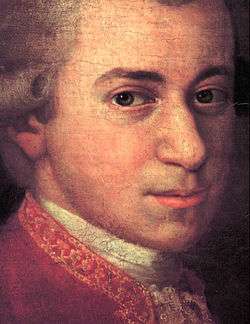Symphony No. 7 (Mozart)
Symphony No. 7 in D major, K. 45, by Wolfgang Amadeus Mozart, was completed in Vienna in January 1768 after the family's return from a visit to Olomouc and Brno in Moravia. The symphony is in four movements. Its first performance was probably at a private concert.[1] The symphony was reworked to become the overture to Mozart's opera, La finta semplice, K. 51,[2] composed and performed later that year, and the overture itself was subsequently adapted further to create a new symphony, known in the Köchel 1964 (K6) catalogue as K. 46a. The autograph of the score is preserved in the Staatsbibliothek Preusischer Kulturbesitz in Berlin.[2]
Movements and instrumentation
For the original (K. 45) version the instrumentation was: strings, 2 oboes, 2 horns, 2 trumpets, timpani, bassoon, continuo. For the symphonic overture (K. 46a) version the trumpets were replaced with flutes, an extra bassoon was added, and the timpani were excised.[1][3]
- Molto allegro, 4/4
- Andante, 2/4
- Menuetto and Trio, 3/4 (This movement was omitted from the "overture" version)[3]
- Molto allegro, 2/4
Performance history
According to analyst Neal Zaslaw, the first occasion on which the K. 45 version could have been heard was a concert given by Prince von Galitzin, the Russian ambassador, at his Vienna residence in late March, 1768.[1] The K. 46b version was heard at the premiere of La finta semplice, at Salzburg on 1 May 1769.[3]
References
Sources
- Giglberger, Veronika: (Preface), translated by J. Branford Robinson. In Wolfgang Amadeus Mozart: Die Sinfonien I, edited by . Bärenreiter-Verlag, Kassel 2005 ISMN M-006-20466-3.
- Osborne, Charles: The Complete Operas of Mozart Gollancz, London 1992 ISBN 0-575-03823-3
- Zaslaw, Neal: Mozart's Symphonies: Context, Performance Practice, Reception OUP, Oxford 1991 ISBN 0-19-816286-3
External links
- Sinfonie in D KV 45: Score and critical report (German) in the Neue Mozart-Ausgabe
- Symphony No. 7: Scores at the International Music Score Library Project
